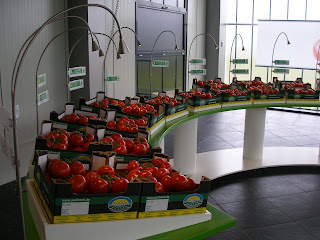Thursday the 28th of July saw us looking at three major sites associated with the Dutch Horticulture industry. All of our visits were facilitated by Dutch Consultant, Ronald Duyvesteijn.
Firstly we visited the Dutch flower auction house FloraHolland, the world's largest, at their Naaldwijk site.
The Dutch auction system utilises an electronic clock that starts at a high price and drops in price. Buyers have to stop the clock at the price they are prepared to pay. The buyers can view the products in a giant cold store before the auction and can then bid for the product as it passes under the clock.
Catherine preparing to purchase at the auction
Stock that is ready for sale is held in the giant storage area and is moved around on a trolley system.
The majority of the day was spent looking at a large scale Tomato crop belonging to growers, C.G.van Winden. This is an eleven and a half hectare site, which is all under glass.
As you can see the glasshouse is a little bigger than the Chisholm version! Here we were able to walk around the highly automated packing area, as well as being allowed to wander around the crop area. This meant that we could observe practical plant growth management techniques, and see first hand how the crop was being managed. As ever, this was another day where we got dressed up in the fashionable white suits.
On the day of our visit the facility was picking and packing 30 tonnes of Tomatoes. These will all go to the export market in Germany.
Crop ready for picking
5kg box of vine tomatoes
Packed boxes awaiting despatch
Our final visit for the day was to the Grape Museum. This is a site that showcases the origins of the Westland area, and how all of the modern glasshouse production of today has developed from grape production in glasshouses that were built against brick walls. The site has a large number of grapes under production and aims to keep alive the history and heritage of the commercial horticulture industry alive.
Of particular interest was the fact that the museum utilises natural predators of soil bourne pests in the form of the small bird, the qual.
Quails seeking out a feed!
Highlights of the tour included a chance to sample the grapes, and a look at the canal where grapes would have loaded on to boats and taken to the markets. We did try and relive the experience by all getting on to the 'mock' canal boat, but this nearly ended in disaster when the boat tipped! With our pride intact and clothing still dry, we headed home at this point!
The day was a varied and interesting one. Below are some comments by the students highlighting what they found of interest:-
The most interesting fact I learned today was that the grey water of approximately 500,000 homes around the Delft, Haag area is collected, treated and cleaned at a central location, until it is at a quality high enough to release back into the natural water system. - Ray
The most impressive aspect of the grape museum was the Integrated pest management. Biological control is the preferred method. No herbicides or insecticides are used, just fungicides for the control of disease.
Quails are used to eat ground dwelling pests, rove mite satchels for the control of spider mites and all weeds are burned not sprayed.This is an effective alternative, far cheaper safer and environmentally friendly - Wayne
The Grape Museum located in the Westland's area of Delft was a fascinating blend of horticultural history and personal stories within an artisan institution that is strongly committed to educating the public about the old ways of growing grapes within the region. A perhaps uncommon fact is that grapes were the first crops grown in glasshouses within this area of the Netherlands, a predecessor to the billion dollar industry that it has now blossomed into. The Museum has a permanent staff of three yet could not function without the dedicated team of over 260 volunteers who grow, prune, graft and harvest the vines throughout the year - Catherine
Today we attended the Naaldwickflower market, the market has been in operation since the early 1900's and now covers an area of 740,000 square meters - 74 hectares, in comparison to the Footscray Market in Melbourne which is 33 hectares and about 1/8 of that is flower market we are a drop in the ocean. The market operates on a daily basis from Monday to Friday and the flowers and pots are brough via the auction system where the bidding starts at the highest point and comes down not up. 80% of stock sold in exported generally within Europe - Kylie






































